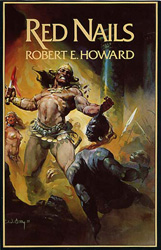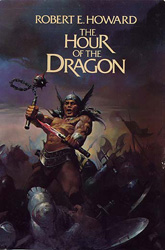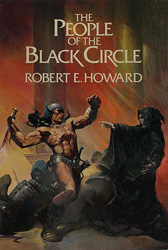Berkley/Putnam Conans: Hardcovered, But Soft-Pedalled?
Monday, August 28, 2006
posted by Steve Tompkins
 Print This Post
Print This Post



What follows is excerpted from “A View From Corona #13,” a January 11, 2003 editorial by Jeremy Lassen. All of Lassen’s Views From Corona are worth reading, and he’s stockpiled good karma as the Night Shade Books editor who convinced Charles Saunders to write “Betrayal in Blood,” an all-new novella dealing with truculent sword-and-sorcery hero Imaro as a haramia (bandit) chieftain for whom nothing exceeds like excess until the armies of the feuding kingdoms he’s been raiding unite against him. “Betrayal in Blood” is now available as the concluding section of Imaro, the extensively revised version of Saunders’ 1981 novel published by Night Shade earlier this year.

I’ve long thought that Karl Edward Wagner’s forewords and afterwords to the 3 Berkley Conan volumes he edited in the late Seventies should be combined and chapbooked as a resource for the galvanized Howard Studies of the early 21st century. And yet Lassen’s disclosure of discrepancies between the paperback Berkleys and the hardcover Berkley/Putnams gobsmacked me; I don’t recall this having been a topic even within REHupa, at least not since 1995. Lassen’s full editorial can be found at www.nightshadebooks.com/edit11.aspx
I can remember the first time I read Conan. I got my hands on the Ace paperbacks when I was in the fourth grade. I had already read various incarnations of Marvel Comic’s Conan, but I was eager to get to the source material — the “real” Conan, as it were. Little did I know, the Ace editions of Conan had as little to do with the original Howard Conan stories as did the Marvel Comics versions. Those Ace editions were heavily edited and re-written by the editors, and also included stories that were not even written by Howard.
We’re not talking moving a comma here or there. We’re not talking about fixing spelling. We are talking about taking non-Conan stories and changing the names and places so that they are suddenly Conan stories that conveniently fill in “blank periods” in his life. We are talking about hiring writers to completely fabricate new stories to fill in the “blank periods” — and then passing off the work as if it were written by Howard.
For a long time, I took my knowledge of the corrupted Conan texts for granted, and thought everyone interested in Conan new about it. But over the last year or so, I have seen several people (most of them younger than me) come into the bookstore I work at, asking for, and trying to complete sets of these “edited” volumes. Many of these fans were surprised when I told them the dubious origins of the texts within those volumes.
I had taken my knowledge for granted because when I had reached the ripe old age of 12 years old, I ran into a beautiful, battered paperback copy of The People of the Black Circle. This was one of three Conan books, edited by Karl Edward Wagner, that collected the original, unaltered texts of Howard’s Conan stories. Unfortunately, this series did not collected all of the Conan stories, and I did not find out why until recently.
These three volumes — Red Nails, The People of the Black Circle, and The Hour of The Dragon featured gorgeous cover paintings by Ken Kelly, and most importantly, introductions by Wagner that called out L. Sprague de Camp and Lin Carter and took them to the mat for their editorial hubris. Karl did not mince words or beat around the bush. He did not like their “alterations” and found it despicable that pastiches were being passed off as original Howard stories.
Wagner knew all about pastiches — he had been paid to write a Conan novel of his own, but he knew enough to know that pastiches would never BE, and should not be presented as, Robert E. Howard’s Conan. He said as much in these introductions, along with a bunch of other things.
And the 12 year old me was RIVETED by those things. I was impressed. All those years of reading the Ace editions, I had been lied to by supposed “authorities” who were packaging up shit, and claiming it was perfume. Finally, here was a stand-up-kind-of-guy who was going out of his way to get the real stuff out there. From that moment on, I was a Karl Wagner fan, and sought out everything he wrote.
At the World Fantasy Convention in Minneapolis last year, I was chatting with some people, and Wagner’s Conan books came up. It was there that I learned why there had only been three books — due to the vagaries of copyright law, and the original contracts that Howard had signed, the Conan stories published in the Wagner volumes were in public domain. Though the estate of R. E. Howard, as represented by Glenn Lord, had “approved” of the Wagner books, the actual copyright to the Conan character was held by Conan Properties LTD, who, it appears, had been in bed with de Camp and Carter, trying to extend the franchise as much and as wide as possible, and had no interest in putting out editions that might draw sales away from their cash cow. “Corrected” editions of the stories under copyright were not going to be made available.
It is clear from Wagner’s introductions that these three volumes were originally published in paperback editions. Sometime after the original publications, however, Berkley issued hard cover editions of these books, and there were SF Bookclub editions based on these hard covers. Sometime in the last 20 years, my ratty paperbacks were replaced by bookclub editions.
Imagine my shock and horror when my friend from the first paragraph mentioned to me one evening that the introductions in the hard cover editions had been changed, so as to be less critical of de Camp and Carter. The long, vandalizing shadow of de Camp and Carter was sliming its way into the very books that were created to undo the damage they had done. I was pissed, and spent 6 months trying to track down paperback copies of these books so that I could see for myself what had been changed. It wasn’t pretty.
In the introduction to The People of the Black Circle (paperback), Wagner writes “…in which the Conan stories were presented with editorial emendations and buried under numerous pastiches by other writers.” In the hard cover editions, “buried under” becomes “mixed with”. That change is fairly innocuous.
In the next paragraph, Karl states: “Previous editions have been marred by the work of overzealous editors, too concerned with usage of commas, spelling variants and apparent ‘inconsistencies.'” In the hard covers, this is substantively altered: “Previous editions were slightly revised and edited, mainly in the area of usage of commas, spelling variants, and apparent inconsistencies.”
It goes on and on, in all three introductions. The tone and framing of Karl’s arguments had been carefully and purposefully changed, apparently, to protect the egos of the above editors.
There are a lot of bad things, and injustices in the world. The fact that some egotistical, money grubbing assholes rewrote some pulp fiction shouldn’t be a big deal. But to me it is. The fact that the whistle blower who came forward and told everybody the emperor had no clothes… the fact that his report was white washed, and changed after the fact — That shouldn’t bother me either — But it does.
LEO ADDS: I do recall this being discussed in REHupa, in detail — someone did a line-by-line comparison and listed all of the changes, can’t recall who.
